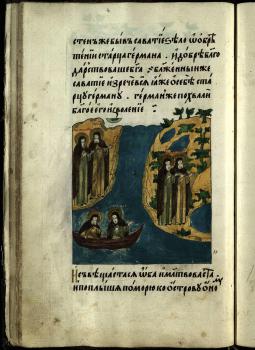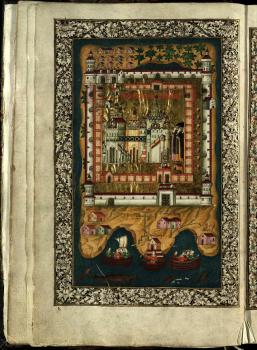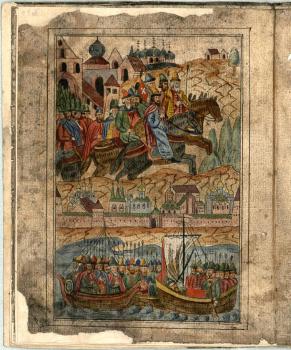Solovetsky Monastery Collection
Since 1928, the Solovetsky Monastery Collection has been held completely intact in the National Library of Russia (formerly the Imperial Public Library, the State Public Library). The collection (фонд 717) consists of 1482 handwritten books from the 14th to 19th centuries, including dozens of unique manuscripts. They belonged to the Founding Fathers, revered elders and heads of the Solovetsky Monastery. Some precious manuscripts were acquired through donations from members of famous princely families (including the ruling dynasties), hierarchs of the Russian Church, people who left a noticeable mark on Russian history. Many books contain the most valuable Old Russian texts, unique historical documents, rare examples of decoration and book miniatures.
The Savior Transfiguration Solovetsky Monastery was founded in the 1430s on an island of the deserted Solovetsky archipelago lying in the White Sea. At this time, the Monk Sabbatius, a tonsurer of St. Cyril's Monastery, and the desert-dweller, the Monk Herman, came here.
After the death of Sabbatius in 1435, Herman moved to the mainland where he met Saint Zosimus, together they returned to the Solovetsky Islands. They settled on a bay shore near a freshwater lake and built a small wooden Transfiguration church. Soon other monks gathered here and established a monastery. Zosimus was elected as the head of the monastery and has left a very noticeable mark on it.
Under Zosimus, the monastery received considerable land and fisheries into its possession, including the Solovetsky Islands. Zosimus built a large wooden Transfiguration Church, a refectory, an Assumption Church. After the death of Zosimus in 1478, the founders of the monastery — the reverend Zosimus and Sabbatius of Solovki were recognized as saints at the council of 1547.
The community of monks on the Solovetsky Islands flourished in the mid-16th century when its head Philip Kolychev began to construct stone buildings.
The Solovetsky Monastery owned vast territories and became not only the center of spiritual life, but also the regional development center.
For several centuries, the famous library of the Solovetsky Monastery played an exceptional role in manuscript production and humanitarian culture in Russia. The library was founded by the Hegumen Dositheos (died after 1514), who commissioned manuscripts for the monastery library in Novgorod at the late 15th century. The history of the Solovetsky Library can be traced from the documents of the monastery archive. These are acts of inventory drawn up when changing the heads of the monastery or the custodian of books. .
The very first surviving inventory of the monastic property for 1514 1 specifies 72 books and, in addition, books donated by Dositheos (46 manuscripts, of which 42 are listed with titles), and a few more books in boxes belonging to individual elders. All these books were held in the monastic treasury along with other property. Thus, in the early 16th century, the monastery possessed about 120 books. The order in which they were arranged is not obvious.
The next written account for 1549 2 when the monastery was “placed under the authority” of Superior Philip Kolychev, listed already 273 manuscripts. They were kept in a special room. Only old, worn out books were transferred to the treasury. The list of manuscripts gives information about their arrangement in the library by format, content and usage in a worship service. The following inventories testify to a widening range and a substantial increase in the number of books in the Solovetsky Library: inventory for 1570 3 listed 308 books, and the inventory for 1597 contained 497 books, including 36 printed volumes. The inventory for 1597 4, marking the appointment of Hegumen Isidorus, is extremely important for the history of the Solovetsky Library, because it contains lists of books, with an indication of their former owners: Philip Kolychev, Hegumen Jacob, Sylvester Blagoveshchensky and many others who made book donations.
A special stone book depository was built in the porch of the Transfiguration Cathedral during the construction of stone passages between the cathedrals and the refectory in the early 17 century. We know about it from the Chronicle of the Solovetsky Monastery for 1602 5. By the mid-17th century, book production reaches its highest peak in the Solovetsky Monastery. The works by Sergius Shelonin and other well-known authors: Hegumen Irinarch, Senior Chorister Gelasius, Joasaph Sorotsky, Ephram Kvashnin, Gurias Putimts, Hegumen Markell, Alexander Bulatnikov are closely associated with this largest book-writing center of pre-Peter the Great's Russia. Books were created not only for the monastery library, but also for sale. First of all, monastic scribes produced the lives of the Solovetsky wonderworkers.
The inventory for 1645 6, (marking the appointment of Hegumen Elias), registered 1015 books in the monastery. 988 of them were housed in the library, including 361 printed volumes. 27 books were kept in the sacristy, including 19 printed ones. The list of books, reflecting their arrangement on shelves, shows the result of almost two centuries of development of the medieval monastic library. The arrangement was very convenient in monastic everyday life. The whole collection was divided into two parts by purpose: liturgical books and those for reading. In turn, the books of each part were arranged by title, and then, books with one title were grouped by format. When copying the manuscripts, the information about the books' former owners was carefully rewritten.
The library was the spiritual treasure of the Solovetsky Monastery. The "book treasury" was in charge of an experienced curator. In the mid-17th century, the monks began to maintain records when this monastic service was passed from one venerable elder to another. The surviving accounts of the "book treasury" allows not only to trace the growth of the monastery collection, but also to mark an important milestone in the book storage system in the 60s of the 17th century. The treasury inventory for 1666 7, compiled during the change of the book custodians, lists books in the alphabetical order, by the first letter of the title.
The new alphabetical order of the library was due to the circumstances of that time. The ideological struggle that troubled the country in the second half of the 17th century directly affected the Solovetsky monastery. The church reform of 1652 generated activities of the Solovetsky scribes who created theological and polemical works to express and defend their views. The monastery library took on new responsibilities, became a kind of "reference tool". A proper arrangement was established to quickly find the required book. It is important to emphasize that the library inventory for 1666 shows a new alphabetic arrangement of books in the monastic library for the first time in Russia. The new arrangement was developed and put into practice by Solovetsky scribes.
The difficult task was solved under the book curator Bogolep. Probably, he was assisted by a former custodian Hieromonk Gerontius, the author of the Fifth Solovetsky Petition, Tales of New Books and other polemical theological writings. After the death of Hegumen Elias in 1659, he became the treasurer and one of the main leaders of the opposition to the new church reforms. After a long period, ideological disputes escalated into armed clashes. For several years (1668–1676), the Solovetsky Monastery withstood the siege of government troops. In the beginning of 1676, with the help of a traitor, the monastery was captured and destroyed. Almost all the defenders died or were cruelly executed.
Compiled in 1676, after the devastation of the Solovetsky Monastery, the property inventory indicates significant losses in the library collection. Thus, the inventory for 1675 8 lists 1680 books, but only 1478 of them remain in the monastery inventory for 1676 .
In the 18th – 19th centuries, the Solovetsky Library expanded its holdings and continued to keep them in alphabetical order. Thus, the inventory for 1765 9, compiled after the reforms of Catherine II, lists 1705 books in the Solovetsky Monastery, including 645 printed ones, and 240 books in the Anzersky hermit community, including 152 printed volumes. Judging by the inventory for 1795 10, printed books were separated from manuscripts by that time.
The last reorganization of the Solovetsky Library was done in 1826–1836 under the Archimandrite Dositheos Nemchinov who is known for his fundamental work on the history of the Solovetsky Monastery. The monk Cassian put the monastery archives and the library in order, as was directed by the archimandrite. All handwritten books were divided into two sections: books on religious subjects and secular books. Inside each of the sections, the books were arranged alphabetically. Each manuscript received a serial number within its section. This number corresponds to the numerator in the modern shelfmark of the Solovetsky Collection. Such arrangement of books in the Solovetsky Collection continues to this day.
In 1854, during the Crimean War, the library as the greatest value was removed from the Solovetsky Monastery to ensure its safety in view of a possible attack on the monastery of the English fleet. 16 boxes of books were held for some time in the Saint Antonius of Siya Monastery, and then were transported to the Kazan Theological Academy in 1855. The collection did not return to the Solovetsky Islands. By the decree of the Synod, it became the property of the Academy. Only 33 handwritten books were returned to the Solovetsky Monastery. Since 1928, when the Solovetsky Collection of the Kazan Theological Academy was received by the State Public Library (now the National Library of Russia), it has been housed in the Manuscripts Department (717 фонд).
The study of the Solovetsky Library began even when the books were in the monastery. In 1834, the member of the Archaeographic Expedition Ya. Berednikov examined the monastery library and archive. He made a report on his work, which attracted the attention of scholars to the unique book collection. In the second half of the 19th century, the Solovetsky Collection was studied systematically: the journal Orthodox Interlocutor, published by the Kazan Theological Academy, introduced many Solovetsky manuscripts as well as with the little-known ancient writings, such as the biblical apocryphal legends. Most of the manuscripts were described in the scientific literature. The research of the Solovetsky heritage has expanded since the 20th century when the collection was transferred into the state depository. Many Lives of Saints, polemical writings by Vassian Patrikeyev, Joseph of Volotsk, Maximus the Greek, Prince Andrey Kurbsky were first published due to the manuscripts of the Solovetsky Library. The attention of scholars to the Solovetsky Collection has continued unabated over the past years. This is one of the most demanded collections of the Manuscripts Department of the National Library of Russia.





